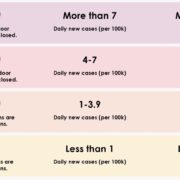Hair salons and barbershops allowed to reopen indoors starting Monday
California Governor Gavin Newsom said on Friday, August 28 that California would be modifying how the state determines which counties can reopen.
Moving away from the previous “watchlist” system, Newsom revealed California’s “Blueprint for a Safer Economy,” which he described as “more stringent” and “steady.”
“It’s simple,” tweeted Newsom on Friday. “Your color determines how businesses can operate in your county.”
NEW: California is launching a Blueprint for a Safer Economy.
It’s simple.
Your county will be assigned a color based on:
– Case rate
– Positivity rateYour color determines how businesses can operate in your county.
Find your color & what’s open ➡️ https://t.co/xtXFwVeWc2 pic.twitter.com/fFXR7rbtU1
— Gavin Newsom (@GavinNewsom) August 28, 2020
The new guideline uses a four-tiered system with colors that correspond with metrics counties must meet in order to begin reopening businesses.
Under the new framework, counties will be assigned one of four colors — purple, red, orange, or yellow based on their case rate and positivity rate.
Counties that have more than seven daily new cases per 100,000 residents and more than 8% positive tests would be under the purple “Widespread” category in which most non-essential indoor businesses must remain closed.
Counties with four to seven daily new cases per 100,000 residents and 5-8% positive tests would be under the red “Substantial” category with some non-essential indoor businesses having to remain closed.
If counties have only one to 3.9 daily new cases per 100,000 residents and 2-4.9% positive tests, they would be designated the orange “Moderate” category in which some businesses are able to open with modifications.
At the lowest end of the spectrum, counties with less than one daily new case per 100,000 residents and less than 2% positive tests would be placed under the yellow “Minimal” category, with most businesses being allowed to reopen with modifications.
Despite the change, 87% of California’s population fell in the purple category as of Friday. This includes much of Northern and Central California, and all of Southern California with the exception of San Diego County which falls in the red category.
Newsom said the metrics would be updated weekly, however, in order to move down to a less restrictive color, counties will have to remain in the mandated levels for 21 days instead of 14 days as previously required under the former watchlist guidelines.
For counties with coronavirus numbers moving upwards, only 14 days will be needed for the counties to be placed in a more restrictive color.
“We’re going to be more stubborn this time and have a mandatory wait time between moves,” said Newsom. “We didn’t do that last time and that is a significant distinction from what we learned in the past.”
While many of California’s businesses and areas like restaurants, churches, gyms, and movie theaters remain limited to outdoor-only operations, hair salons and barbershops will be allowed to open for indoor services starting Monday so long as they follow health mandates like wearing masks and enforcing physical distancing when required.
Shopping malls, which were also forced to close doors last month, will be allowed to open at a 25% capacity maximum.
Newsom also added that an “emergency brake” would be used if hospitalization numbers started to look troubling.
“I want to remind you the governor talked about this ‘emergency brake’ that if we see hospital numbers starting to really increase, that the ICU in a community is becoming overwhelmed, then we will work with that county to make more immediate changes and pause, and maybe even take a step back,” said Health and Human Services Secretary Dr. Mark Ghaly.
The first update of counties under the new framework will be released on September 8.







